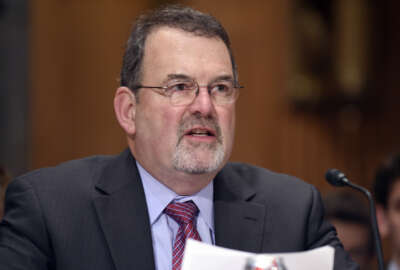
Huge bill coming due for out-of-date technology
Federal CIO Tony Scott said new data from government contractors shows billions of dollars are going to maintain hardware and software that either is no longer...
CAMBRIDGE, Maryland — Tony Scott, the federal chief information officer, gets his chance May 25 on Capitol Hill to make his case for why federal information technology needs help now more than ever.
Scott will come before the House Oversight and Government Reform Committee armed with some new information from government contractors.
“When we looked at that data, what we saw was in aggregate more than $3 billion of hardware, software and other things that we bought, that we are currently paying maintenance for, [and] are going to go end-of-life and [are] no longer things we can get spare parts or service or patches in the case of software. That alone tells you there is a fairly significant problem,” said Scott in an interview with Federal News Radio after speaking at the ACT-IAC Management of Change Conference May 24. “What that doesn’t include is the things that are already end-of-life that we are not paying maintenance on or things we chose not to pay maintenance on in the first place. It’s anybody’s guess what those numbers are. But I don’t think they are small.”
Scott said OMB informally asked vendors, many of the big suppliers of hardware and software to the government, to help them assess the size of the problem. He said these contractors looked at what network, infrastructure, storage, computer and other technologies agencies currently are paying for on contracts.
“One of the things we looked at was when you look at those maintenance contracts you can tell when things will go out of service, meaning that company is no longer going to provide support, spare parts and so on,” he said. “A number of companies who I think understand the predicament that we are in conversations with them said, ‘Hey, we think we might have some data that could help you triangulate on this number.’ When we came up with this $3 billion, it was through some of these mechanisms that we said this is an appropriate number. If anything, it might underestimate the real demand, but you have to start somewhere and this felt like it was a good place to start.”
Scott likely will start with this data as well as the ongoing cyber challenge when he testifies Wednesday before the House committee. Along with Scott, Defense Department CIO Terry Halvorsen; Beth Killoran, acting CIO of the Department of Health and Human Services; Terry Milholland, IRS chief technology officer and David Powner, director of IT issues for the Government Accountability Office; are scheduled to appear.
The committee said the hearing will focus, in part, on the results of the December 2015 letter to all 24 major agencies requesting information on agencies’ use of legacy IT.
The hearing also will give Scott maybe his most public chance to use this data to build a stronger case for the $3.1 billion IT Modernization Fund President Barack Obama requested in his fiscal 2017 budget. Rep. Steny Hoyer (D-Md.), introduced the bill to create the fund.
“The IT Modernization Fund is a lever for us to change the way we think about how we do IT,” Scott said during the conference. “The longer we wait and the more we sit on our hands, the bigger this problem is likely to get so I think the time is now to do something. I’m open to other suggestions, but I know going out and tin cupping 7,000 different investments or projects to try to fund something or capture savings from somewhere else to start the fund and then to start remediating things is probably not going to have a high probability of success. I feel the urgency of this problem and I know many of you do as well.”
Scott is indirectly responding to Rep. Will Hurd’s (R-Texas) recent comment that the administration should look at taking savings from the data center consolidation effort and applying those savings to fund modernization efforts rather than ask for new appropriations.
Hurd is one of several doubters or skeptics on Capitol Hill when it comes to the IT Modernization Fund. Hurd and Rep. Jason Chaffetz (R-Utah), chairman of the oversight committee, have been among the most vocal about not wanting to authorize additional money for federal IT.
That is why Wednesday’s hearing is so critical for the administration.
There are 20 co-sponsors of the ITMF bill, and for now, Scott said that’s a good enough broad cross-section support across Capitol Hill.
“I expect there to be vigorous debate on this. The folks and staff on the Hill that we have interacted with have asked some really good, hard questions about how this would work. It’s helped us make the proposal better,” he said. “We will go out with some guidance at some point and we will take public comment on as well because we really want this to work.”
Scott said he is unsure of the exact date of when he will release the draft guidance, but he expects it to work in parallel with the 2017 budget development efforts.
“There is a journey that we have to go on whether we have the modernization fund or not, which is understanding what we have, having a vision of what we would replace it with and then some theory of the case in terms of how you get there,” he said. “We will be working with the agencies on just those steps through various forums.”
OMB received some new support May 24 from the IT Alliance for Public Sector. In a new blog post, Trey Hodgkins, ITAPS senior vice president for public sector, said the government’s reliance on outdated technologies poses a serious security risk.
“We shouldn’t miss the larger point of the hearing, which is federal agencies and entities are stuck in a time warp, paying billions upon billions of dollars to keep putting band aids on old and outdated technologies that need to be replaced,” Hodgkins wrote. “The benefits will far outweigh the costs to upgrade.”
The cyber rationale is probably OMB’s strongest case to Congress — at least the one they will understand most readily.
Scott said improving agency cybersecurity is a core factor for the ITMF. But there also is an economic issue.
“We’re spending money today on stuff that has one-tenth or one-twentieth or one-fiftieth the capacity of what we could be getting for the same money,” he said. “There are systems in the federal government today that run significant capabilities, [but] your iPad has more compute power than some of these platforms. There are cases that it takes 400 to 500 people to support the equivalent of an iPad and it just makes common sense that that is good money after bad and we should stop doing it. Now unfortunately, and this is why ITMF is important, there is a bubble cost. You have to build the new capability before you can get rid of the old. We just can’t cut off government services while we figure it out. We have to keep the old stuff going while we build new capabilities.”
Copyright © 2025 Federal News Network. All rights reserved. This website is not intended for users located within the European Economic Area.
Jason Miller is executive editor of Federal News Network and directs news coverage on the people, policy and programs of the federal government.
Follow @jmillerWFED
Related Stories





